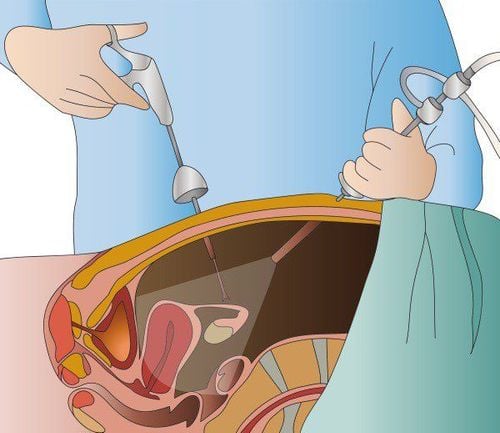This is an automatically translated article.
Laparoscopy is usually performed in the abdomen or in a woman's reproductive system. Laparoscopic surgeries usually involve a thin tube called a laparoscope, which is inserted into the abdomen through a small incision.1. What is laparoscopy?
Laparoscopy is a type of surgery to check for problems in a woman's abdomen or reproductive system. Laparoscopy uses a thin tube called a laparoscope. It is inserted into the abdomen through a small incision. An incision is a small cut made through the skin during surgery. Tube with camera. This allows the surgeon to see inside the body without causing major trauma to the patient.
Laparoscopy is known as a minimally invasive surgical method. It allows for a shorter hospital stay, faster recovery, less pain, and smaller scarring compared to traditional (open) surgery.
2. When is laparoscopy used?
For people with abdominal symptoms, laparoscopic surgery can be used to diagnose:
Tumors and other tumors; Jam; Unexplained bleeding; Infection . For women, it can be used to diagnose and/or treat:
Fibroids, tumors that form inside or outside the uterus; Ovarian cysts, fluid-filled sacs that form inside or on the surface of the ovaries; Endometriosis, a condition in which the normal tissue lining the uterus grows outside of it; Pelvic prolapse, which is a condition in which the reproductive organs slip in or out of the vagina; It can also be used to:
Eliminate an ectopic pregnancy, a pregnancy that develops outside the uterus. A fertilized egg cannot survive an ectopic pregnancy. It can be life-threatening for pregnant women; Hysterectomy, removal of the uterus. A hysterectomy may be done to treat cancer, abnormal bleeding, or other disorders; Have a tubal ligation, a procedure used to prevent pregnancy by blocking a woman's fallopian tubes; Treatment of urinary incontinence, accidental or involuntary leakage of urine. Surgery is sometimes used when a physical exam or imaging tests, such as X-rays or ultrasounds, do not provide enough information to make a diagnosis.

Đối với những người có các triệu chứng ở bụng, phẫu thuật nội soi có thể được áp dụng để chẩn đoán
3. Why need laparoscopy?
You may need a laparoscopy if you:
Severe or chronic pain in your abdomen or pelvis; Feeling of a lump in the abdomen; Abdominal cancer. Laparoscopic surgery can remove some types of cancer; Women who have heavier menstrual periods than usual; As a woman who wants a surgical form of birth control; Being a woman having trouble getting pregnant. Laparoscopy can be used to check for blockages in the fallopian tubes and other conditions that can affect fertility.
4. What happens during laparoscopy?
Laparoscopic surgery is usually done in a hospital or outpatient clinic. It usually includes the following steps:
Undress and put on a hospital gown; You will lie on the operating table; Most endoscopy is done while you are under general anesthesia. General anesthesia is a drug that makes you unconscious. It ensures you won't feel any pain during the surgery. You will be given medication through an intravenous (IV) line or by inhaling air from a mask. A specially trained doctor called an anesthesiologist will give you this medicine; If you don't have general anesthesia, a medicine will be injected into your abdomen to numb the area so you don't feel any pain; When you are unconscious or your abdomen is completely numb, the surgeon will make a small incision just below or near the navel; An endoscope, a thin tube with a camera attached, will be inserted through the incision; More small incisions can be made if exploration or other surgical instruments are needed. A transducer is a surgical instrument used to explore areas inside the body; During this procedure, a gas is introduced into your abdomen. This widens the area, making it easier for the surgeon to see inside your body; The surgeon will move the endoscope around the area. They will see pictures of the abdomen and pelvic organs on a computer screen; Once this is done, the surgical instruments and most of the discharge will be removed. Small incisions will be closed; Then was moved to the emergency room; You may feel drowsy or nauseous for a few hours after your colonoscopy. Currently, Vinmec International General Hospital is one of the leading prestigious hospitals in the country, trusted by a large number of patients for medical examination and treatment. Customers who choose laparoscopy at Vinmec will enjoy advantages such as:
Experienced doctors in endoscopy. Modern equipment, high treatment efficiency: C-Am system, intraoperative ultrasound machine helps to locate clearly and help surgeons monitor the patient's condition during and after surgery. To be able to bring the best endoscopic results, limit complications during and after surgery. The most modern German flexible endoscope system for clear, accurate images, easy to use. Intraoperative consumables are passed through strict sterilization testing procedures, Vinmec only uses high quality products and especially is used only once to ensure sterility and deliver results. best for the patient. With modern facilities, accurate diagnosis, selection of appropriate surgical methods, customers only take a single dose of prophylactic antibiotics, do not have to use high-dose antibiotics for a long time, no pain, no hospital stay. short, only 1-2 days. Therefore, saving treatment costs Professional services: Modern civilized disease prevention system, each patient one room is fully serviced from monitoring disease parameters, meals, rest regimes Rest, exercise, health education, each patient room is equipped with amenities like a 5-star hotel apartment, patient information is confidential.
Please dial HOTLINE for more information or register for an appointment HERE. Download MyVinmec app to make appointments faster and to manage your bookings easily.













